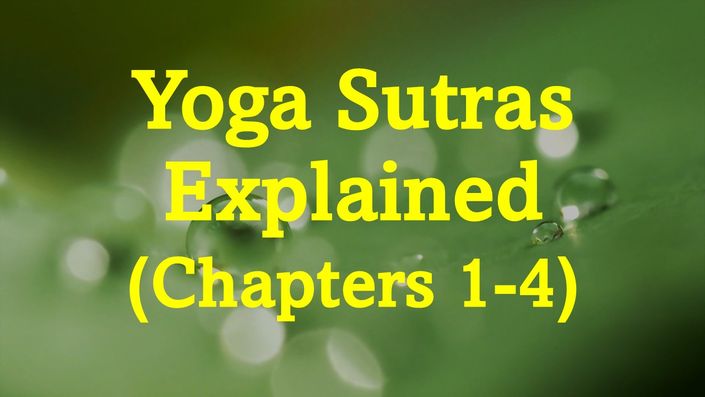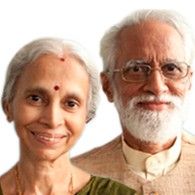
Yoga Sutras Explained (Chapters 1-4)
This course combines Yoga Sutra: Chapter 1, Chapter 2, Chapter 3 and Chapter 4. This lesson consolidates verse by verse explanation the Yoga Sutras of Patanjali.
This lesson consolidates and explains verse by verse explanation the Yoga Sutras of Patanjali.
Your Instructor (s)

A. G. Mohan was a student of "the father of modern yoga," Yogacarya Sri T. Krishnamacharya (1888-1989), for eighteen years. He is the author of several books on yoga, including Yoga for Body, Breath, and Mind; Yoga Reminder; Yoga Therapy; and Krishnamacharya: His Life and Teachings.
Read more for a detailed timeline of Mohan’s studies
Indra Mohan has been practicing and teaching yoga for more than three decades. Along with her husband A.G. Mohan, she continues to study and deepen her knowledge in yoga and related fields. She is one of the few people who received a post-graduate diploma in yoga from Krishnamacharya. Her profound understanding of yoga and Ayurveda and how it applies to all aspects of our health, particularly in the area of women’s’ health is inspirational.
Course Videos
-
StartYoga Sutra Chapter 1: Samadhi Pada
-
StartWhat is Yoga? (5:08)
-
StartResult of restraint and otherwise (4:28)
-
StartRestraining the activities of the mind (5:05)
-
StartThe five categories of thought processes for nirodha (3:21)
-
StartThe thought and latent impression cycle (2:40)
-
StartThe list of five thought processes (3:05)
-
StartValid knowledge – direct perception (3:17)
-
StartInference (3:20)
-
StartVerbal and written testimony (2:13)
-
StartFalse knowledge/viparyaya (2:29)
-
StartKnowledge based on words (without corresponding objects) – vikalpa (2:48)
-
StartSleep is a thought processs (vritti) (4:03)
-
StartWhat is memory? (3:21)
-
StartSummary of sutras 5-11 (4:42)
-
StartPractice and detachment are the means to nirodha (3:23)
-
StartWhat is practice? (2:26)
-
StartWhen will the practice become deeply rooted? (3:40)
-
StartThe four stages of detachment (3:31)
-
StartNature of ultimate detachment (3:57)
-
StartWhat is Samprajnata Samadhi? (3:02)
-
StartWhat is Asamprajnata Samadhi? (3:37)
-
StartTwo categories of yogis and rebirth (2:21)
-
StartSteps to reach the state of permanent peace (3:59)
-
StartSummary of sutras 1-22 (7:22)
-
StartConcept of Isvara: Introduction to sutras 23-29 (3:19)
-
StartSpecial devotion to Isvara - Sutra 1:23 (4:18)
-
StartWho is Isvara? - Sutra 1:24 (3:37)
-
StartSpecial features of Isvara 1:25&26 (3:34)
-
StartThe methodology of pranidhana 1:27 (3:40)
-
StartHow to meditate with pranava 1-28 (3:27)
-
StartThe result of Isvara pranidhana 1-29 (3:34)
-
StartThe nine mental distractions - Sutra 30 (3:42)
-
StartThe accompanying symptoms - Sutra 31 (3:52)
-
StartStay with one support - Sutra 32 (2:59)
-
StartThe bhavanas to cleanse the mind - Sutra 33 (4:51)
-
StartUse of breath to bring about mental steadiness - Sutra 34 (3:08)
-
StartExtraordinary sense perceptions for mental steadiness - Sutra 35 (2:48)
-
StartMeditation on heart lotus or a mind devoid of desire - Sutra 36&37 (3:12)
-
StartMeditation on sleep-dream or an object of one's choice - Sutra 38&39 (3:38)
-
StartSummary of sutras 1.31-39 (5:34)
-
StartMental steadiness leads to samapatti - Sutra 40 (3:00)
-
StartNature of samapatti - Sutra 41 (3:57)
-
StartNature of realization with vikalpa – savitarka and savicara samapattis - Sutra 42 (3:16)
-
StartNature of realization without vikalpa – nirvitarka and nirvicara samapattis - Sutras 43-44 (3:27)
-
StartRealization of the ultimate root cause sutras - Sutras 45-46 (2:28)
-
StartNirvicara samadhis and its resultant knowledge - Sutras 47-49 (2:53)
-
StartNirbija samadhi and ultimate realisation - Sutras 50-51 (2:02)
-
StartSummary of sutras 40-51 (6:11)
-
StartYoga Sutra Chapter 2: The 'Practice' Chapter
-
StartIntro: Krishnamacharya on the second chapter and kriya yoga (01:13) (1:12)
-
StartIntro: Krishnamacharya on the second chapter and Kriya Yoga (2:06)
-
StartThe why of the second chapter? (5:17)
-
StartWhat is Kriya Yoga? (4:22)
-
StartWhat is Tapas? (3:58)
-
StartIs Svadhyaya self study? (3:39)
-
StartIsvara Pranidhana is not giving up of the fruits of our actions (3:21)
-
StartThe benefits of Kriya Yoga (3:42)
-
StartThe mental afflictions - Klesas (4:53)
-
StartThe four states of mental afflictions (3:35)
-
StartAvidya - wrong opposite knowledge (5:11)
-
StartThe I-feeling (3:43)
-
StartAttachment - Raga (4:27)
-
StartAversion - Dvesa (3:14)
-
StartFear - Abhinivesa (3:52)
-
StartHow to dissolve gross and subtle klesas (3:09)
-
StartSummary of sutras 1-11 (7:28)
-
StartResult of actions based on the mental afflictions (4:36)
-
StartBirth, life span and experiences (3:41)
-
StartUnhappiness is inbuilt in happiness (6:10)
-
StartUnhappiness due to the changing gunas (3:53)
-
StartPotential of unhappiness in worldly pleasures (4:00)
-
StartRoot cause of unhappiness (3:57)
-
StartNature of mind and matter (4:37)
-
StartHow the gunas are spread in layers (4:10)
-
StartNature of the Seer (5:05)
-
StartMind – bondage or freedom (3:09)
-
StartPlurality of Consciousness and singularity of the world (3:28)
-
StartRealization through connection (3:17)
-
StartRoot cause of bondage is mental afflictions (2:41)
-
StartThe state of permanent peace (3:03)
-
StartThe means to permanent peace (2:56)
-
StartThe seven steps to ultimate realization (2:34)
-
StartSummary of sutras 11-27 (8:25)
-
StartThe eight limbs of yoga – the means to realization (4:16)
-
StartList of eight limbs (4:14)
-
StartThe five dont’s - yamas (3:31)
-
StartHow a yogi should practice the yamas (2:59)
-
StartThe five do’s - niyamas (3:05)
-
StartHow to handle perverse/negative thoughts (3:41)
-
StartCause-intensity-execution of perverse/negative thoughts (3:58)
-
StartResult of mastery over non harmfulness-truth and non-stealing (3:44)
-
StartResult of mastery over celibacy and non-acquisitiveness (3:39)
-
StartResult of mastery over external and internal cleanliness (3:33)
-
StartResult of mastery over contentment and tapas (3:40)
-
StartResult of mastery over svadhyaya and Isvara pranidhana (3:50)
-
StartQualities of asana (2:34)
-
StartMeans to master the asanas and the results (3:34)
-
StartPranayama (3:40)
-
StartThree types of pranayama (4:00)
-
StartResult of mastery of pranayama (2:45)
-
StartResults in the fourth type of pranayama (3:21)
-
StartSenses control and the result (3:18)
-
StartSummary of the sutras 28-55 (7:13)
